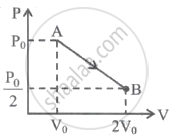Advertisements
Advertisements
प्रश्न
Estimate the fraction of molecular volume to the actual volume occupied by oxygen gas at STP. Take the diameter of an oxygen molecule to be 3Å.
उत्तर १
Diameter of an oxygen molecule, d = 3 A = 3 x 10-10 m. Consider one mole of oxygen gas at STP, which contain total NA = 6.023 x 1023 molecules.
Actual molecular volume of `6.023 xx 10^23` oxygen molecules
`V_"actual" = 4/3 pir^3 . N_A`
`= 4/3 xx 3.14 xx (1.5)^3 xx 10^(-3) xx 6.02 xx 10^23 m^3`
`= 8.51 xx 10^(-6) m^3`
`= 8.51 xx 10^(-3) litre` [∵ `1 m^3 = 10^3 litre`]
:. Molecular volume of one mole of oxygen
`V_"actual" = 8.51 xx 10^(-3) litre`
At STP, the volume of one mole of oxygen
`V_"molar" = 22.4 litre`
`V_"actual"/"V_"molar" = 8.51 xx 10^(-3)/22.4" = 3.8 xx 10^(-4) ~~ 4 xx 10^(-4)`
उत्तर २
Diameter of an oxygen molecule, d = 3Å
Radius, r = `d/2 = 3/2 ` = 1.5 Å = 1.5 × 10–8 cm
Actual volume occupied by 1 mole of oxygen gas at STP = 22400 cm3
Molecular volume of oxygen gas, `V = 4/3 pir^3. N`
Where, N is Avogadro’s number = 6.023 × 1023 molecules/mole
`:. V = 4/3 xx 3.14 xx (1.5 xx 10^(-8))^3 xx 6.023 xx 10^23 = 8.51 cm^3`
Ratio of the molecular volume to the actual volume of oxygen = `8.51/22400`
`= 3.8 xx 10^(-4)`
APPEARS IN
संबंधित प्रश्न
An air bubble of volume 1.0 cm3 rises from the bottom of a lake 40 m deep at a temperature of 12 °C. To what volume does it grow when it reaches the surface, which is at a temperature of 35 °C?
Consider a collision between an oxygen molecule and a hydrogen molecule in a mixture of oxygen and hydrogen kept at room temperature. Which of the following are possible?
(a) The kinetic energies of both the molecules increase.
(b) The kinetic energies of both the molecules decrease.
(c) kinetic energy of the oxygen molecule increases and that of the hydrogen molecule decreases.
(d) The kinetic energy of the hydrogen molecule increases and that of the oxygen molecule decreases.
Calculate the mass of 1 cm3 of oxygen kept at STP.
An electric bulb of volume 250 cc was sealed during manufacturing at a pressure of 10−3 mm of mercury at 27°C. Compute the number of air molecules contained in the bulb. Avogadro constant = 6 × 1023 mol−1, density of mercury = 13600 kg m−3 and g = 10 m s−2.
Use R=8.314J K-1 mol-1
The density of an ideal gas is 1.25 × 10−3 g cm−3 at STP. Calculate the molecular weight of the gas.
Use R=8.31J K-1 mol-1
Figure shows a vessel partitioned by a fixed diathermic separator. Different ideal gases are filled in the two parts. The rms speed of the molecules in the left part equals the mean speed of the molecules in the right part. Calculate the ratio of the mass of a molecule in the left part to the mass of a molecule in the right part.

Estimate the number of collisions per second suffered by a molecule in a sample of hydrogen at STP. The mean free path (average distance covered by a molecule between successive collisions) = 1.38 × 10−5 cm.
Use R = 8.31 JK−1 mol−1
The ratio Cp / Cv for a gas is 1.29. What is the degree of freedom of the molecules of this gas?
Work done by a sample of an ideal gas in a process A is double the work done in another process B. The temperature rises through the same amount in the two processes. If CAand CB be the molar heat capacities for the two processes,
One mole of gas expands obeying the relation as shown in the P-V diagram. The maximum temperature in this process is equal to ______.

